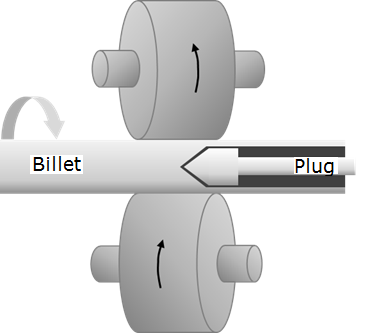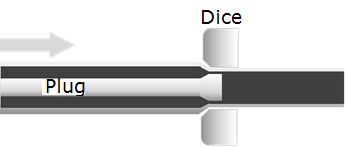Seamless Pipe and Semi-Seamless Pipe
Seamless pipe is made from pushing a hole through a solid bar. On the other hand, semi-seamless pipe is made by first rolling up a steel sheet and welding it into a cylinder. After that, the cylinder goes through a drawing process where the welding joint is no longer observable on the surface of the pipe thus giving it the name “semi-seamless”.
1. Seamless Pipe
■ Manufacturing Method
The typical manufacturing method is called Mannesmann process. A round bar billet is first heated to the necessary temperature. While keeping pressure on the outer surface of the bar, a plug is pushed through the billet to create a hollow pipe. This manufacturing method is suitable for larger volume production lots. It can create large bores and is also good for manufacturing thick wall pipes.
■ Features
There’s no joint, so the original strength and integrity of the material is kept. The drawback is dimensional precision is limited by this manufacturing process.
●Image of the manufacturing process

2. Semi-Seamless Pipe
■ Manufacturing Method
This method starts with not a billet but a steel strip coil. An “uncoiler” pulls out the steel strip continuously, the edges of the strip are rolled up and joined by electric resistance welding forming a long pipe. A very high current passes through the joining area creating very high temperature that melts the material at the area. The melted material is pressed and joined together without using additive welding material. Weld bead, or protruding area of the joint, will then be shaved off. After cooling, the pipe then goes through further processes such as straightening and drawing.
■ Features
This manufacturing process is suitable for smaller volume production lots. Size is flexible and precision is higher for pipes made from this method.
● Video of tube making process
● Image of the drawing process

3. Different Applications of Steel Pipes
■ Plumbing, Piping
The purpose is to allow fluid (gas, liquid, etc.) flow inside the pipe. The outer diameter is designated by “A” and the wall thickness is determined by a schedule numbers. These pipes are often called schedule pipes (e.g. gas pipe, water pipe, etc.). Nonstandard sizes are usually not available. Schedule pipes are also called tubes (e.g. hydraulic tubes, air conditioning tubes, etc.) if the actual outer diameter is predetermined. Examples are found in hydraulic tubes, air conditioning tubes, etc.
■ Structural
Types and availability vary depending on architectural and machinery application. Sizes are standardized in the case of architectural application. There is a lot of different kinds of steel pipes for machinery parts, so selection depends on usage, quality and precision required.
4. Selection of Steel Pipes
When selecting standardized steel pipes, because they are widely available in significant quantity, the option would be selecting a proper vendor. In general, the lead-time will be short since most vendors stock these items and the price would be cheaper.
If nonstandard steel pipe is necessary, depending on the size needed, semi-seamless is favorable as the production lot is comparatively smaller and the sizes are more flexible.


